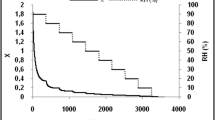Abstract
Rehydration kinetics of Salicornia herbacea prepared by vacuum drying at 70 or 80°C was studied at water temperature of 30, 60, and 90°C, respectively. A 2-term 5-parameter exponential decay model was used to describe the rehydration process. The rehydration times for the S. herbacea to reach maximum water absorption (t M ) at each rehydration condition varied depending on the rehydration temperature and the drying air temperature. The inverse of the time (1/t M ) showed linear temperature dependency as described by the Arrhenius-type relationship. The activation energy values for the S. herbacea dried at 70 and 80°C were 17.66 and 21.06 kJ/mol, respectively.
Similar content being viewed by others
References
Cunningham SE, McMinn WAM, Magee TRA, Richardson PS. Experimental study of rehydration kinetics of potato cylinders. Food Bioprod. Process. 86: 15–24 (2008)
Krokida MK, Marinos-Kouris D. Rehydration kinetics of dehydrated products. J. Food Eng. 57: 1–7 (2003)
Dadali G, Demirhan E, Özbek B. Effect of drying conditions on rehydration kinetics of microwave dried spinach. Food Bioprod. Process. 86: 235–241 (2008)
McMinn WAM, Magee TRA. Physical characteristics of dehydrated potatoes-Part II. J. Food Eng. 33: 49–55 (1997)
Krokida MK, Philippopoulos C. Rehydration of dehydrated foods. Dry. Technol. 23: 799–830 (2005)
Kim CS, Song TG. Ecological studies on the halophyte communities at western and southern coasts in Korea. Korean J. Ecol. 6: 167–176 (1983)
Jang HS, Kim KR, Choi SW, Woo MH, Choi JH. Antioxidant and antithrombus activities of enzyme-treated Salicornia herbacea extracts. Ann. Nutr. Metab. 51: 119–125 (2007)
Min JG, Lee DS, Kim TJ, Park JH, Cho TY, Park DI. Chemical composition of Salicornia herbacea L. J. Food Sci. Nutr. 7: 105–107 (2002)
Lee JT, Jeong YS, An BJ. Physiological activity of Salicornia herbacea and its application for cosmetic materials. Korean J. Herbol. 17: 61–69 (2002)
Jeong CY, Rhy JS, Choi CK, Jeon BS, Park JW, Shin GG, Kim BK, Bae DW, Cha JY. Supplemented effect of Salicornia herbacea extract powder on preparation and quality characteristics of fermented milk product. J. Life Sci. 14: 788–793 (2004)
Tong CH, Lund DB. Effective moisture diffusivity in porous materials as a function of temperature and moisture content. Biotechnol. Progr. 6: 67–75 (1990)
Gekas V, Lamberg I. Determination of diffusion coefficients in volume changing systems-application in the case of potato drying. J. Food Eng. 13: 317–326 (1991)
Sanjuan N, Simal S, Bon J, Mulet A. Modelling of broccoli stems rehydration process. J. Food Eng. 42: 27–31 (1999)
Maskan M. Microwave/air and microwave finish drying of banana. J. Food Eng. 44: 71–78 (2000)
Namsanguan Y, Tia W, Devahastin S, Soponronnarit S. Drying kinetics and quality of shrimp undergoing different two-stage drying processes. Dry. Technol. 22: 759–778 (2004)
Garcia-Pascual P, Sanjuan N, Bon J, Carreres J, Mulet A. Rehydration process of Boletus edulis mushroom: Characteristics and modeling. J. Sci. Food Agr. 85: 1397–1404 (2005)
Lee KT, Farid M, Nguang SK. The mathematical modelling of the rehydration characteristics of fruits. J. Food Eng. 72: 16–23 (2006)
Rhim JW. Hydration kinetics of soybeans. Food Sci. Biotechnol. 12: 303–306 (2003)
Maskan M. Drying, shrinkage, and rehydration characteristics of kiwifruits during hot air and microwave drying. J. Food Eng. 48: 177–182 (2001)
Bakalis S, Karathanos VT. Study of rehydration of osmotically pretreated dried fruit samples. Dry. Technol. 23: 533–549 (2005)
Solomon WK. Hydration kinetics of lupin (Lupinus albus) seeds. J. Food Process Eng. 30: 119–130 (2007)
Bello MO, Tolaba MP, Suárez C. Hydration kinetics of rice kernels under vacuum and pressure. Int. J. Food Eng. 4: 1–21 (2008)
Hsu KH, Kim CJ, Wilson LA. Factors affecting water uptake of soybeans during soaking. Cereal Chem. 60: 208–211 (1983)
Abu-Ghannam N, McKenna B. The application of Peleg’s equation to model water absorption during the soaking of red kidney beans (Phaseolus vulgaris L.). J. Food Eng. 32: 391–401 (1997)
Prakash S, Jha SK, Datta N. Performance evaluation of blanched carrots dried by three different driers. J. Food Eng. 62: 305–313 (2004)
Planinić M, Velić D, Tomas S, Bilić M, Bucić A. Modelling of drying and rehydration of carrots using Peleg’s model. Eur. Food Res. Technol. 221: 446–451 (2005)
Singh GD, Sharma R, Bawa AS, Saxena DC. Drying and rehydration characteristics of water chestnut (Trapa natans) as a function of drying air temperature. J. Food Eng. 87: 213–221 (2008)
Rhim JW, Jones VA, Swartzel RS. Texture degradation kinetics of sweet potatoes during heat treatment. Food Sci. Biotechnol. 11: 24–28 (2002)
Lee JH, Kim HJ. Vacuum drying kinetics of Asian white radish (Raphanus sativus L.) slices. Lebensm. -Wiss. Technol. 42: 180–186 (2009)
Akgun NA, Doymaz Ý. Modeling of olive cake thin-layer drying process. J. Food Eng. 68: 455–461 (2005)
Arora S, Shivhare US, Ahmed J, Raghavan GSV. Drying kinetics of Agaricus bisporus and Pleurotus florida mushrooms. T. ASAE 46: 721–724 (2003)
Lopez A, Iguaz A, Esnoz A, Virseda P. Thin-layer drying behavior of vegetable wastes from wholesale market. Dry. Technol. 18: 995–1006 (2000)
Kaya A, Aydin O, Demirtas C. Drying kinetics of red delicious apple. Biosyst. Eng. 96: 517–524 (2007)
Author information
Authors and Affiliations
Corresponding author
Rights and permissions
About this article
Cite this article
Lee, J.H., Rhim, JW. Rehydration kinetics of vacuum-dried Salicornia herbacea . Food Sci Biotechnol 19, 1083–1087 (2010). https://doi.org/10.1007/s10068-010-0152-5
Received:
Revised:
Accepted:
Published:
Issue Date:
DOI: https://doi.org/10.1007/s10068-010-0152-5




